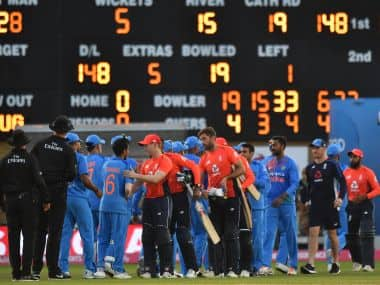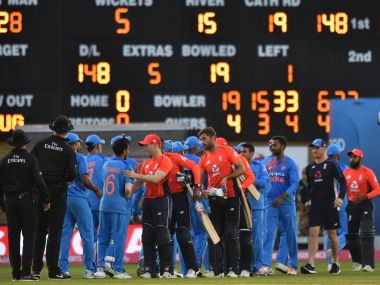Momentum fuels success in Twenty20 (T20) cricket. It is the jostling for it that is strangely reminiscent of the mindless mayhem and violence of a Mad Max movie. The teams throw in their various pairs and combinations in a desperate bid to retain momentum for as long as possible. India’s experienced and battle-hardened top-order batsmen were well aware of the critical value of momentum. But like in so some aspects of the game of cricket, knowing is one thing, but the ability to retain poise and deliver under pressure is something else altogether. India came into Sophia Gardens with a 1-0 lead in the three-match series. But after they lost momentum within the first quarter of their innings, it was always a case of playing catch-up. [caption id=“attachment_4686801” align=“alignleft” width=“380”] England defeated India by five wickets in second T20I in Cardiff. AFP[/caption] None of the first three batsmen in the line-up — Rohit Sharma, Sikhar Dhawan or KL Rahul — can say that they did not provide the opposition a toe-hold in the series. Had the trio accounted for 50 to 60 runs, England might well have been shut out for the rest of the match. But before the Powerplay overs were done, it was India that looked increasingly vulnerable after having surrendered momentum. On a pitch that had far more life than the one provided for the first T20I, the top-order meltdown was stunning. Rohit, like he has done on numerous occasions in his career, threw caution to the wind, rather than spending a little more time gauging the pace and bounce on the pitch. He played a pre-meditated pull to get out in only the second over while his partner Dhawan juggled and dropped his bat while running between the wickets to be run out. Of course there is no question of playing yourself in, in this format of the game. But conventional wisdom suggests one of the top three batsmen to bat long while others would do the big-hitting. Worse, KL Rahul, the man in form after his scintillating century in Manchester, gave the English team a tremendous leg-up when he played a wild shot to be the second batsman to be dismissed in the fifth over. A score of 22 for three in 4.5 overs placed England firmly in the driving seat. Had even one of the first three batsmen batted till the end and acted as a support for Virat Kohli and MS Dhoni, India’s final total could have been better than 148/5 that they eventually managed. The home team suffered some minor hiccups in the chase, but given their powerful batting line-up, the result was seldom in doubt. Kuldeep Yadav, star of the first T20I, was ineffective as Jonny Bairstow and Alex Hales belted him. Maybe their spin-bowling machine Merlyn prepared them well for handling Kuldeep and Yuzvendra Chahal’s wares. Alternately, the pitch was not as helpful to spin and it is also possible that Kuldeep would have kept his variations to the minimum in a bid to escape over-exposure. Bhuvaneshwar Kumar and Umesh Yadav bowled brilliantly at times, even if they conceded runs to wild heaves interspersed with excellent shots. The odd-sized outfield — more trapezium than circle — would have taken some getting used to, especially for the bowlers. Field setting in oddly-shaped outfields is a challenge. Angles of shots differ and thus cutting it off calls for greater understanding of the dimensions of the outfield. The bowlers too need to gauge the nooks and corners that would be easier to protect. The English tactics were simple. They played just one spinner who encouraged shots to the square boundaries or the vast and deep mid-wicket fence. The pacers simply dropped it short to get batsmen to play horizontal shots. Those few vital runs that were saved when India took time to get a hang of the outfield was the difference between victory and loss. Importantly, India, despite losing momentum early on, stayed competitive till the end. That should count for something going into Sunday’s deciding encounter.
England defeated India by five wickets in second T20I in Cardiff. AFP[/caption] None of the first three batsmen in the line-up — Rohit Sharma, Sikhar Dhawan or KL Rahul — can say that they did not provide the opposition a toe-hold in the series. Had the trio accounted for 50 to 60 runs, England might well have been shut out for the rest of the match. But before the Powerplay overs were done, it was India that looked increasingly vulnerable after having surrendered momentum. On a pitch that had far more life than the one provided for the first T20I, the top-order meltdown was stunning. Rohit, like he has done on numerous occasions in his career, threw caution to the wind, rather than spending a little more time gauging the pace and bounce on the pitch. He played a pre-meditated pull to get out in only the second over while his partner Dhawan juggled and dropped his bat while running between the wickets to be run out. Of course there is no question of playing yourself in, in this format of the game. But conventional wisdom suggests one of the top three batsmen to bat long while others would do the big-hitting. Worse, KL Rahul, the man in form after his scintillating century in Manchester, gave the English team a tremendous leg-up when he played a wild shot to be the second batsman to be dismissed in the fifth over. A score of 22 for three in 4.5 overs placed England firmly in the driving seat. Had even one of the first three batsmen batted till the end and acted as a support for Virat Kohli and MS Dhoni, India’s final total could have been better than 148/5 that they eventually managed. The home team suffered some minor hiccups in the chase, but given their powerful batting line-up, the result was seldom in doubt. Kuldeep Yadav, star of the first T20I, was ineffective as Jonny Bairstow and Alex Hales belted him. Maybe their spin-bowling machine Merlyn prepared them well for handling Kuldeep and Yuzvendra Chahal’s wares. Alternately, the pitch was not as helpful to spin and it is also possible that Kuldeep would have kept his variations to the minimum in a bid to escape over-exposure. Bhuvaneshwar Kumar and Umesh Yadav bowled brilliantly at times, even if they conceded runs to wild heaves interspersed with excellent shots. The odd-sized outfield — more trapezium than circle — would have taken some getting used to, especially for the bowlers. Field setting in oddly-shaped outfields is a challenge. Angles of shots differ and thus cutting it off calls for greater understanding of the dimensions of the outfield. The bowlers too need to gauge the nooks and corners that would be easier to protect. The English tactics were simple. They played just one spinner who encouraged shots to the square boundaries or the vast and deep mid-wicket fence. The pacers simply dropped it short to get batsmen to play horizontal shots. Those few vital runs that were saved when India took time to get a hang of the outfield was the difference between victory and loss. Importantly, India, despite losing momentum early on, stayed competitive till the end. That should count for something going into Sunday’s deciding encounter.
India vs England: Hosts' discipline with ball in second T20I robbed Virat Kohli and Co of crucial momentum
Vedam Jaishankar
• July 7, 2018, 13:42:04 IST
India came into Sophia Gardens with a 1-0 lead in the three-match series. But after they lost momentum within the first quarter of their innings, it was always a case of playing catch-up.
Advertisement
)
End of Article